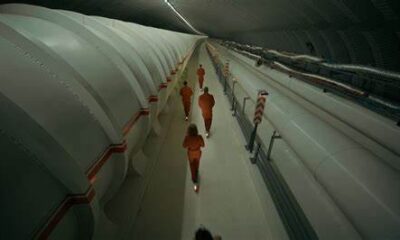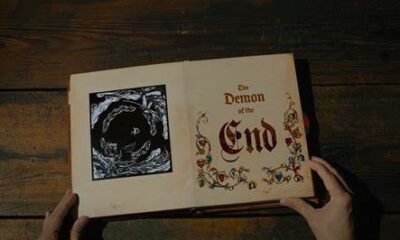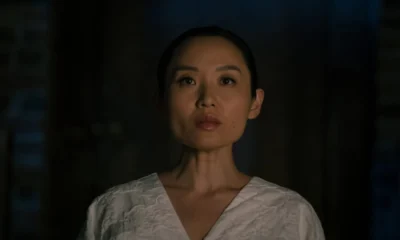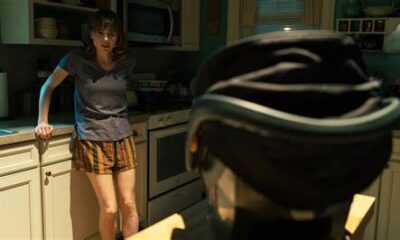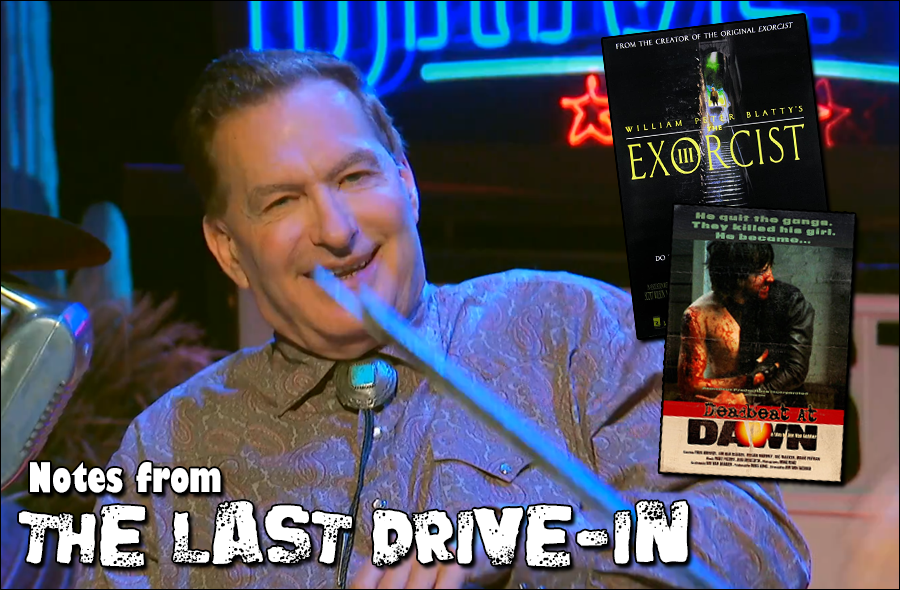
Notes from The Last Drive-In: S2E5
We’re past the halfway point for season two of The Last Drive-In with Joe Bob Briggs and I am already feeling sad. Let’s not dwell on what is coming to an end, however. We already have confirmation of a summer special, after all. For now, let’s dive into two movies that cannot be more different.
Tonight’s double feature consisted of William Peter Blatty’s The Exorcist III (1990) and Jim Van Bebber’s Deadbeat at Dawn (1988). I was back to live-tweeting the double-feature for the night, so apologies now for any awful puns and jokes you see embedded into this review and recap.
The Exorcist III (1990)
Opening Rant: Toxic masculinity and a poorly thought out razor ad.
The sequel to the sequel to one of the most culturally important horror films of all time had a lot that could have gone wrong. What is amazing is that The Exorcist III is actually damn good despite the awful The Exorcist II: The Heretic. A lot of that is the result of the tenacity of the strange and passionate William Peter Blatty, author of the original Exorcist novel. That’s not to say that The Exorcist III is without flaws, however. The film has a number of issues, but ultimately these problems are not enough to derail what turns out to be a strange follow-up to the alarming possession of Regan MacNeil.
The film is, foremost, a masterclass of acting. The acting here is so good that it sets George C. Scott opposite Brad Dourif and Scott is the one who comes off as subdued compared to Dourif. It is a very “talky” sort of film which seems unusual for a Drive-In feature, but it works. Most of the deaths occur off-screen, but it works. Like last season’s The Changeling, also featuring George C. Scott, The Last Drive-In makes room for something a little more measured and, I dare say, classier in its approach to horror. It is the film’s restraint in the visual excess of horror that allows what it does engage in to mostly succeed. Namely an amazing transition from Jason Miller to Brad Dourif via an editing trick and perhaps one of the finest jumpscares ever committed to film.
Yet, the film also has substantial problems. The murdering off of one key character sacrifices a fascinating homosocial relationship for cheap motivation. A strange dream sequence comes off as a budget Twin Peaks scene and is goofier than insightful. Lastly, a hasty attempt to include an exorcism into a story that didn’t need it ruins the ending to what was an overall creepily effective film.
So while The Exorcist III mostly does what is necessary of a good sequel, specifically for The Exorcist, too many issues mar it. As brilliant as some of Blatty’s choices were as the mind behind the film it is necessary to have a seasoned veteran to bounce off of when it comes to film.
Joe Bob’s assessment of the film is perfectly fine. Three stars is a fair score for the movie. He ultimately had a lot to say about it. There is a trend where the more mixed he is on a film the more in-depth Joe Bob’s analysis and discussion of the film usually come off. It makes sense because things we love sometimes are harder to discuss than things we can be critical of. The Exorcist III is just one of those films where it was a perfect storm of issues narratively and behind the camera while also navigating the legacy of the original film.
While the second feature of the night is definitely more fun and a better Drive-In movie overall, The Exorcist III provides viewers with the sort of material that drives them to watch the redneck horror host in the first place; an honest assessment of the film, both good and bad, with observations about the craft of film itself. It sounds dismissive to just say it is “typical Joe Bob,” but that is a good thing. This is a perfect example of the appeal of The Last Drive-In.
I like The Exorcist III. I think people who claim to like it more than the original are probably being contrarians. It’s not a bad movie and it is probably the best sort of sequel to The Exorcist that a fan can ask for, but the fact remains that it is a deeply flawed film. Ultimately, I couldn’t rate it higher than three and a half Cthulhus.
 (3.5 / 5)
(3.5 / 5)
Best Line: “This I believe in… I believe in death. I believe in disease. I believe in injustice and inhumanity, torture and anger and hate… I believe in murder. I believe in pain. I believe in cruelty and infidelity. I believe in slime and stink and every crawling, putrid thing… every possible ugliness and corruption, you son of a bitch. I believe… in you.” – Kinderman to what is clearly Pazuzu.

Deadbeat at Dawn (1988)
Opening Rant: Poop coffee.
I think I first saw Deadbeat at Dawn at the end of my junior-high years. I recall it was a shitty VHS bootleg and it came from a kid named Eli who was super into Insane Clown Posse and bootlegged VHS copies of the hentai Dragon Pink and Golden Boy for all of the weird kids at my junior-high which turned out to be a lot of us.
I mention this because this sounds sketchy and grimy and is sort of the perfect way to experience the sketchy and grimy film that is Deadbeat at Dawn. The film is juvenile and punk in a fundamental way of just not giving a shit and indulging in such bizarre anarchistic impulses on and off camera that it becomes this sort of outsider art. I say this with love: Deadbeat at Dawn is an absolutely insane 81 minutes that probably should never have been released.
Deadbeat at Dawn is independent film-making at its most impulsive and punk. Cobbled together over four years by a director (Jim Van Bebber) who also plays the lead, the film was often shot without permits and resulted in a series of Jackass-style moments witnessed by unsuspecting people in the local community. It’s all dumb film students recording dumb, dangerous stuff and eventually managing to pull a movie out of it. Basically what every aspiring film-school student secretly desires to do.
It’s not a good movie but it is also a good movie. Deadbeat at Dawn is not well-written, the performances are amateur, and the story is just kind of non-existent. It features a sequence of the director/lead practicing his nunchucks and screaming in a Dayton, Ohio graveyard dealing with feelings about his budget-Satanist girlfriend. It’s an example of one of those films that know not to take itself too seriously and have fun with itself.
Yet, the film also is a gritty Kung Fu vengeance film, punctuated with moments of true despair with a simultaneously repulsive and sympathetic protagonist with one of the most insane last 20 minutes put to film. So much of this movie shouldn’t work but does. The film is just so grimy and textured. In another universe this would have been paired with Street Trash.
Joe Bob’s assessment of Deadbeat at Dawn is a full four stars punctuated by him saying “I loved it.” The film is pretty much perfect Drive-In fare and an example of something so beloved the conversation around it, while always insightful on the show, is also kind of dialed back. Perhaps this is in awe of the audacity of what Jim Van Bebber achieved. Regardless, several Sam Raimi references, including his own thoughts on the “punk action film” pop up in addition to referencing Joseph Campbell.
Perhaps the best part of all of this, however, is how Joe Bob Briggs highlights Van Bebber’s own philosophy: “Pain is temporary. Film is forever.” Our horror host points out just how crazy and punishing the assembly of this feature was. I know Joe Bob Briggs has written a lot of books, but I don’t know if he’s written one about Deadbeat at Dawn. If not, he should.
What impressed me most about Deadbeat at Dawn is how well it holds up. I’ve seen it maybe twice since junior-high, but goddamn does it still hold up. As a punk music fan, I think one of my livetweet riffs summarize my feelings on this film pretty well.
Deadbeat at Dawn is totally worth four and a half Cthulhus. It’s too audacious not to be.
 (4.5 / 5)
(4.5 / 5)
Best Line: “I hate people, man. I don’t care. I don’t give a shit. I don’t give a shit about nothin’. Man, all my life people have fucked with me. Don’t you fuck with me, man. I just fuckin’ hate people. I hate people and I don’t care. I just don’t fuckin’ care. I don’t care. I’m the baddest motherfucker you ever saw, man.” – Bone Crusher

HMTL Drive-In Totals
So, here are the official totals, courtesy of Shudder. It was a good night.
As for our totals?
- 4 Helicopters
- $9-million in Reshoots
- 20 Dense Minutes
- 57 Weeks on the NYT’s Best Seller List
- $10,000 Scholarship
- Carp Monologing
- Inexplicable Fabio
- Spontaneous Dourif
- Down n’ Dirty Catholicism
- Awkward Crash Zoom
- Joe Bob Confusing
- Bible Versing
- Actor Slapping
- Hillbilly Joking
- Graveyard Fighting
- Graveyard Nunchucking
- Raimi Referencing
- Campbell Referencing
- Snake Slapping
- Dual Jocking
- But Punching
- South Carolina Joking
- Ouija Fu
- Creepy Confession Fu
- New York The-ate-er Fu
- Biblical Research Fu
- Powerwalk Fu
- Map Fu
- Burp Fu
- Sloppy Bar Pass Fu
- Sommelier Fu
- Car Fu
- Poorly Dubbed Cat Fu
- Darcy Cosplay: The Angel of Death
- Silver Bolo Award: The Horror Movie Podcast

Episode Score
Man, what a good night. These films could not be more different than one another. One is more literary and the other is more punk. It’s a strange combination that results in yet another great episode of The Last Drive-In.
 (4 / 5)
(4 / 5)
And remember, folks…
The Drive-In will never die.
Movies n TV
Wheel of Time A Question of Crimson Is a Political Espionage Delight
Episode two of Wheel of Time felt like the beginning of a long journey. Stories are unfolding, lives are changing, and blood is spilling.
Let’s discuss.
The story
We begin this episode in the past with Elayne’s mother, Queen Morgase. It turns out her rise to the throne was a bit, shall we say, cutthroat. So when she shows up at the White Tower, Siuan is concerned.
She might have reason to be, too.
Meanwhile, Rand, Egwene, Moiraine, Lan and Aviendha are in the Spine of The World. As they travel through some of the most breathtaking lands I have ever seen on a TV show, Egwene is plagued with nightmares. We think at first that’s just her trauma working itself through her system. But we soon find out that it might not be that straightforward.
Finally, Perrin returns home to heal after his hand is almost cut in half. But when he gets there he finds the town has been infested by Children of The Light. And they’re looking for him.
What worked
There was something heartwarming in this episode about political espionage and choking religious persecution. And that is Elayne’s relationship with her family.
I have consumed a lot of fantasy content with royal families. And I have never once heard a princess call her mother ‘Mum’. I’ve never seen royal siblings get along. And I have sure as hell never seen a princess have a good relationship with her step-parent.
This was refreshing. Even though Queen Morgase is kind of a horrible person she seems like a good mother. And that’s an unexpected delight.

Of course, this is just one storyline among many. And while this can sometimes be overwhelming, in this case it wasn’t.
I’ll be honest, some of these storylines are going to drag for me. I know this because I’ve read some of the Wheel of Time books and I have an idea that not all the characters exactly pique my interest.
No one likes all the characters. No one likes all the storylines. While I am here for the political espionage between Queen Morgase and Siuan, not everyone likes it. While others might be fascinated with Selene trying to win Rand back, I couldn’t care less.
Having multiple storylines keeps everyone’s attention better. So long as things don’t get out of hand. Things can easily get out of hand. But this seems to be managed well.
So far.
What didn’t work
As I mentioned above, I’m not thrilled with Rand’s story at this point. And while it’s fine to not like a storyline when there are this many to choose from, it’s not fantastic that the one I like the least is the one involving our two main characters. And anytime we were with the team at the Spine of The World, the only thing that brought me joy was Moirain’s hat. It reminded me of Stockard Channing’s hat in Practical Magic.
The problem is that Rand is Charlie Brown with controversial magical powers. He is boring, serious, and pessimistic.
And yes, I understand that he has a heavy emotional burden and he’s the Dragon Reborn and that’s quite taxing and all. But let’s be fair, there isn’t a single person in this show that doesn’t have a heavy burden. And most of them manage to be fun occasionally.

All that being said, this episode of Wheel of Time did exactly what it needed to do. It set up conflicts at each of the three locations. It established emotional ties between the characters and the events. And it established goals for everyone.
This was, in short, a solid episode. Not groundbreaking, not mind-blowing or life changing. It was simply good. It was entertaining and moved the plot forward.
Well done.
 (3.5 / 5)
(3.5 / 5)
Movies n TV
Wheel of Time Returns With A Bang
Wheel of Time is back for season three. There are mixed feelings regarding this. Last season, there were some serious pacing issues. And some serious sticking to the book’s storyline issues. But we’re two seasons in, and we don’t give up so easily. So let’s dive into episode one, To Race the Shadow.
By the way, I highly recommend watching this episode with the subtitles on. You’ll see why.
The story
We begin this episode with Liandrin facing a trial of sorts for her rampant betrayal. She does her best to gaslight her Aes Sedai sisters into thinking that Siuan Sanche is the real traitor.

When that doesn’t work, she reveals how many Black Aes Sedai have actually infiltrated the tower.
Spoiler, it’s a lot.
In the aftermath, our whole team gathers to drink and enjoy one night of relaxation before they head out to the Tear to form an army for Rand. All is going well until they’re attacked by myriad creatures and a sentient axe.
What worked
This episode was long. It had a run time of an hour and eleven minutes. And a lot of that run time was spent in heavy dialog scenes.
Fortunately, these were well-done scenes.
If you’re going to have a lot of talking scenes, there are good ways and bad ways to do it. Last season, we saw lots of examples of the bad way to do it. But this episode did it well. For one thing, other things were going on while conversations were taking place. The characters are drinking, playing games, walking through an interesting city. And the scenes themselves didn’t stretch out. They weren’t repetitive. We heard what the character had to say, then we moved on.
It was also nice that the point of these scenes wasn’t just info dumps. We had character development. We had romantic interactions. We had plot development and foreshadowing.
Overall, this episode felt like what it was. A moment of calm before a storm.
Taking a step back, I’d be remiss if I didn’t address the fight scene at the start of the episode. Because it was epic.
The magic looked amazing. The martial arts that went along with it looked fantastic. The costumes were beautiful. It was just incredibly fun to watch.
More than that, it was emotional. We lost some characters in that fight that were important. And it was clearly emotionally shattering for many of our characters, who found themselves betrayed by people they trusted.
So many of them.
It was a great way to open the season.
What didn’t work
Despite that, this episode wasn’t without its flaws.
First off, there were a lot of dialog scenes. And they were good scenes, as I’ve already discussed. But it was one after another after another. And when your episode is, again, an hour and eleven minutes, it’s maybe a little much to have so much chit-chat. Couldn’t some of these conversations, important as they were, have been moved to maybe another episode?
Finally, I want to talk about Egwene’s travel through the arches.

I feel like maybe there were some deleted scenes here. Because there must have been more to that visit than what we saw, right?
We could have seen Egwene battle Rand. That would have been badass and emotionally devastating. We could have seen her with a quiet life with Rand back home at the Two Rivers. We could have seen anything except for the quick clip of Rand in a bloody river, followed by Egwene being shoved back out in a bloody shift.
No products found.
Bad job. But at least it wasn’t an extended scene of Moiraine collecting bathwater, and then taking a bath while looking sad. If we’d started this season with another scene like that, it might have broken my brain.
Amazon dropped the first three episodes at once. So we’ll be back soon to talk about episode two. See you then.
 (4 / 5)
(4 / 5)
Movies n TV
Entertaining as hell: Eight Legged Freaks (2002) Review
Early 2000s is a special era for the industry. It accepts the cheesiness and corniness of movie making, in turn producing some gems in their own right. Eight Legged Freaks starring David Arquette and young Scarlet Johanson is a horror comedy about giant spiders who overtake a small town. As crazy as that premise sounds, the movie surprisingly has a ton of heart and is super entertaining. Let’s review, shall we?
Plot
We start Eight Legged Freaks with a shot of toxic waste spilling into the water supply of Joshua, a spider farm owner. He is friends with Mike, one of our protagonists, who is a science geek and a spider enthusiast. Mike notices something quite right upon visiting Joshua, but no one takes him seriously. We are then introduced to the rest of the crew. Mike’s mother Samantha, the town sheriff, is too busy chasing Ashley, his sister, who is dating the town mayor’s son Bret (something Samantha does not approve of). We also have Chris, who returns to the town to save his father’s legacy in the town mines. He has opposition from Wade, Bret’s father, who wants to use the mines for his business ventures. Lots of drama going on that will only get juicier once the spiders get loose.
The creepy crawlies quickly dispose of Joshua and make their grand appearance after Ashley rejects Bret’s advances, abandoning him in the middle of a desert. A glorious chase sequence ensues as the spiders make their way towards the town, wreaking havoc on its residents. In a true horror fashion (which the movie acknowledges), it takes some convincing from Mike and then from Samantha for the town to take the threat seriously. The tongue-in-cheek style of narrative adds the comedy aspect to a movie that would otherwise burn out fairly quickly.
The remaining characters hide out in a shopping mall as it’s the only somewhat sturdy building in the area. This doesn’t last long as the spiders break in, forcing them to run through the mines. Their resources to fight the creepy crawlies off are limited as the methane gas doesn’t allow them to use firearms. Such conditions require resourceful thinking from Chris, who uses perfume to fend off the leader of the spider group and save himself during the climax of the movie.
Character dynamics are not forgotten once the action kicks in. We have Chris confessing his long-term feelings for Samantha which she knew all along, which provided some comedic relief. Bret also reunites with Ashley and apologises for being an asshole. Mike finally gets the appreciation he deserves as his knowledge saves the townsfolk more than once during the whole ordeal.
We end the movie with the town’s radio show person telling the story as an urban legend during his segment. This brings it into question – how much of it happened the way he said it did? We can only guess…
Overall thoughts
Eight Legged Freaks is a fun creature feature with some self-aware commentary on genre tropes that doesn’t take itself too seriously. The acting is good, the pacing fitting and the characters are likeable enough for you to want them to make it through. Definitely a must watch, if you don’t suffer from arachnophobia, that is.
 (5 / 5)
(5 / 5)
- What do you get when you cross toxic waste with a bunch of exotic spiders? Eaten! The townies of Prosperity, Arizona will all become a screaming smorgasbord if mutated arachnids as big as SUVs have their way in this comedy/horror crowd pleaser whose creators include the producers of Independence Day and Godzilla
- Spiders that leap like gazelles, web-spitting spiders, spiders that suck your insides out as if through a straw—they’re all among the behemoths conjured up by an inventive effects team
- David Arquette (Scream) leads the two-legged stars, mobilizing the citizenry in a last-ditch fight to survive
Last update on 2025-03-10 / Affiliate links / Images from Amazon Product Advertising API


